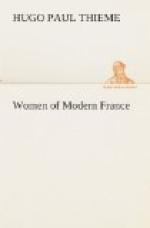From this element of prostitution was disentangled, to a large extent, the great gallantry of the eighteenth century. This was accomplished by adding an elegance to debauch, by clothing vice with a sort of grandeur, and by adorning scandal with a semblance of the glory and grace of the courtier of old. Possessing the fascination of all gifts, prodigalities, follies, with all the appetites and tendencies of the time, these women attracted the society of the period—the poets, the artists, even the scientists, the philosophers, and the nobility. Their reputation increased with the number and standing of their lovers. The genius of the eighteenth century circled about these street belles—they represented the fortune of pleasure.
As the church would not countenance the marriage of an actress, she was forced to renounce the theatre when she would marry, but once married a permit to return to the stage was easily obtained. Society was not so severe as the laws; it received actresses, sought out, and even adored them; it received the women of the stage as equals, and many of them were married by counts and dukes, given a title, and presented at court. The regular type of the prostitute was tolerated and even received by society; “a word of anger, malediction, or outrage, was seldom raised against these women: on the contrary, pity and the commiseration of charity and tenderness were felt for them and manifested.” This was natural, for many of them—through notoriety—reached society and, as mistresses of the king, even the throne itself. “If such women as Mme. de Pompadour were esteemed, what principles remained in the name of which to judge without pity and to condemn the debauches of the street,” says Mme. de Choiseul, one of the purest of women.
This class usually created and established the styles. There is a striking contrast between the standards of beauty and fashions of the respective periods of Louis XIV. and Louis XV.: “The stately figure, rich costume, awe-inspiring peruke of the magnificent Louis XIV.—the satins, velvets, embroideries, perfumes, and powder of the indolent and handsome Louis XV., well illustrate the two epochs.” The beauty of the Louis XIV. age was more serious, more imposing, imperial, classic; later in the eighteenth century, under Louis XV., she developed into a charming figure of finesse, sveltesse et gracilite, with an extremely delicate complexion, a small mouth and thin nose, as opposed to the strong, plump mouth and nez leonin (leonine nose). More animated, the face was all movement, the eyes talked; the esprit passed to the face. It was the type of Marivaux’ comedies, with an esprit mobile, animated and colored by all the coquetries of grace.




